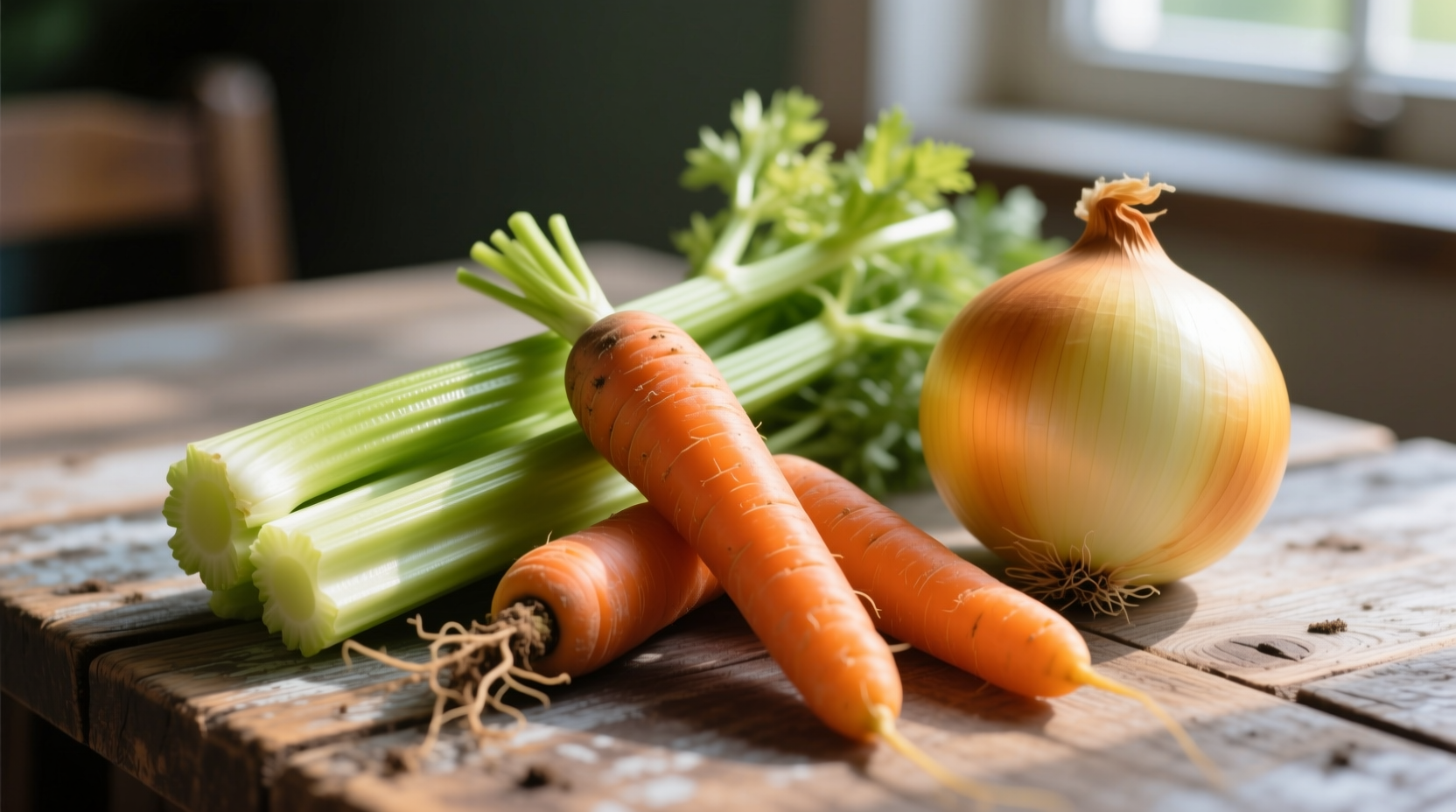Celery, carrot, and onion form the classic mirepoix ratio (2:1:1) used as the foundational flavor base in French cuisine and similar preparations worldwide, essential for building depth in soups, stews, sauces, and braises.
Unlock professional-level cooking with this simple vegetable trio that transforms ordinary dishes into culinary masterpieces. When properly prepared, this combination creates a flavor foundation that enhances everything from weeknight dinners to holiday feasts. Let's explore exactly how to maximize this kitchen essential.
The Science Behind the Perfect Flavor Foundation
Understanding why celery, carrot, and onion work together requires examining their chemical synergy. When sautéed slowly in fat, these vegetables undergo the Maillard reaction and caramelization processes that create complex flavor compounds. The onion provides sulfur compounds and natural sugars, carrots contribute sweetness through beta-carotene conversion, and celery adds aromatic compounds that bind these elements together.
According to research from the Culinary Institute of America, this specific vegetable combination creates more than 40 distinct flavor compounds when properly cooked, significantly more than any single vegetable could produce alone. The key lies in the precise ratio and cooking technique.
| Vegetable | Primary Flavor Compounds | Optimal Cooking Time | Key Contribution |
|---|---|---|---|
| Onion | Sulfur compounds, fructose | 8-10 minutes | Base sweetness and depth |
| Carrot | Beta-carotene, terpenes | 10-12 minutes | Natural sweetness balance |
| Celery | Phthalides, apiol | 7-9 minutes | Aromatic binding agent |
Mastering the Technique: Step-by-Step Preparation
The standard mirepoix ratio of 2 parts onion, 1 part carrot, and 1 part celery isn't arbitrary—it's scientifically optimized for balanced flavor development. Here's how to prepare it correctly:
- Uniform Cutting: Dice all vegetables to the same size (small dice for quick dishes, medium for soups and stews)
- Order of Operations: Start with onions (they take longest), add carrots next, then celery last
- Temperature Control: Cook over medium-low heat—never let vegetables brown
- Moisture Management: Cover pan initially to release vegetable moisture, then uncover to evaporate
- Timing: Cook 15-20 minutes until vegetables are translucent but not colored
"Many home cooks rush this step," explains Antonio Rodriguez, professional chef and culinary educator. "The magic happens in that slow sweat—when you take time to properly develop the mirepoix, your entire dish benefits from deeper, more complex flavors that can't be achieved through shortcuts."

Regional Variations Across Global Cuisines
While French cuisine standardized the 2:1:1 ratio, culinary traditions worldwide have adapted this vegetable foundation:
| Cuisine | Base Name | Ratio | Distinctive Additions |
|---|---|---|---|
| French | Mirepoix | 2 onion : 1 carrot : 1 celery | Bay leaf, thyme |
| Italian | Soffritto | Equal parts all three | Garlic, parsley |
| Cajun/Creole | Holy Trinity | 2 onion : 1 celery : 1 bell pepper | Garlic, cayenne |
| Spanish | Refogado | 3 onion : 1 carrot : 1 tomato | Garlic, paprika |
Historical records from the University of Gastronomic Sciences show this technique evolved over centuries. The earliest documented version appears in 17th century French cookbooks, but similar vegetable bases existed in Roman cuisine as documented in Apicius' De Re Coquinaria. The modern standardized ratio emerged during the Escoffier era when French culinary techniques became systematized.
When Not to Use This Classic Combination
Despite its versatility, this vegetable base has specific limitations. Understanding these context boundaries prevents culinary missteps:
- Delicate seafood dishes: The strong celery flavor can overwhelm subtle fish flavors
- Quick stir-fries: Requires longer cooking than high-heat Asian techniques allow
- Raw applications: The flavor profile only develops through proper sweating
- Vegetarian dishes needing umami: Add mushrooms or tomato paste for depth
For Asian-inspired dishes, consider substituting with ginger, garlic, and scallions. For Latin American cooking, replace celery with bell peppers to create the "holy trinity" variation that better complements regional spices.
Storage and Freshness Optimization
Proper storage maintains the flavor compounds that make this trio effective. According to USDA research, these vegetables retain optimal flavor compounds for different periods:
- Onions: Store in cool, dark place (30-60 days); never refrigerate whole onions
- Carrots: Remove green tops and store in perforated plastic in refrigerator (3-4 weeks)
- Celery: Wrap tightly in aluminum foil (2-3 weeks); avoid plastic bags which trap moisture
Pre-cut vegetables lose flavor compounds 40% faster than whole vegetables, so prepare your mirepoix just before use for maximum impact. If you must prepare ahead, store in airtight container with damp paper towel for no more than 24 hours.
Practical Applications for Home Cooks
Transform your everyday cooking with these specific applications:
- Weeknight soups: Start with 1 cup mirepoix for every 4 cups broth
- Pasta sauces: Cook mirepoix before adding tomatoes for richer flavor
- Meat braises: Sear meat first, then cook mirepoix in same pan to incorporate fond
- Grain dishes: Sauté mirepoix before adding rice or quinoa
- Vegetable stocks: Use equal parts all three plus leek tops and herb stems
Professional chefs often freeze pre-prepared mirepoix in oil for quick use. Simply portion into ice cube trays, cover with olive oil, freeze, then transfer to freezer bags. Each cube equals one standard mirepoix portion for soups and sauces.
Troubleshooting Common Mistakes
Avoid these frequent errors that undermine your flavor foundation:
- Browning instead of sweating: High heat creates bitter compounds—keep temperature medium-low
- Uneven cutting: Different sizes cook at different rates—aim for uniform 1/4" dice
- Skipping the sweat step: Rushing means undeveloped flavors—allow full 15-20 minutes
- Adding salt too early: Salt draws out moisture—wait until vegetables begin to soften
- Using old vegetables: Stale produce lacks volatile compounds—use within 2 weeks of purchase
When executed properly, this simple vegetable combination creates what culinary professionals call "background notes"—flavors you don't consciously detect but that make the entire dish taste more complete and satisfying.











 浙公网安备
33010002000092号
浙公网安备
33010002000092号 浙B2-20120091-4
浙B2-20120091-4